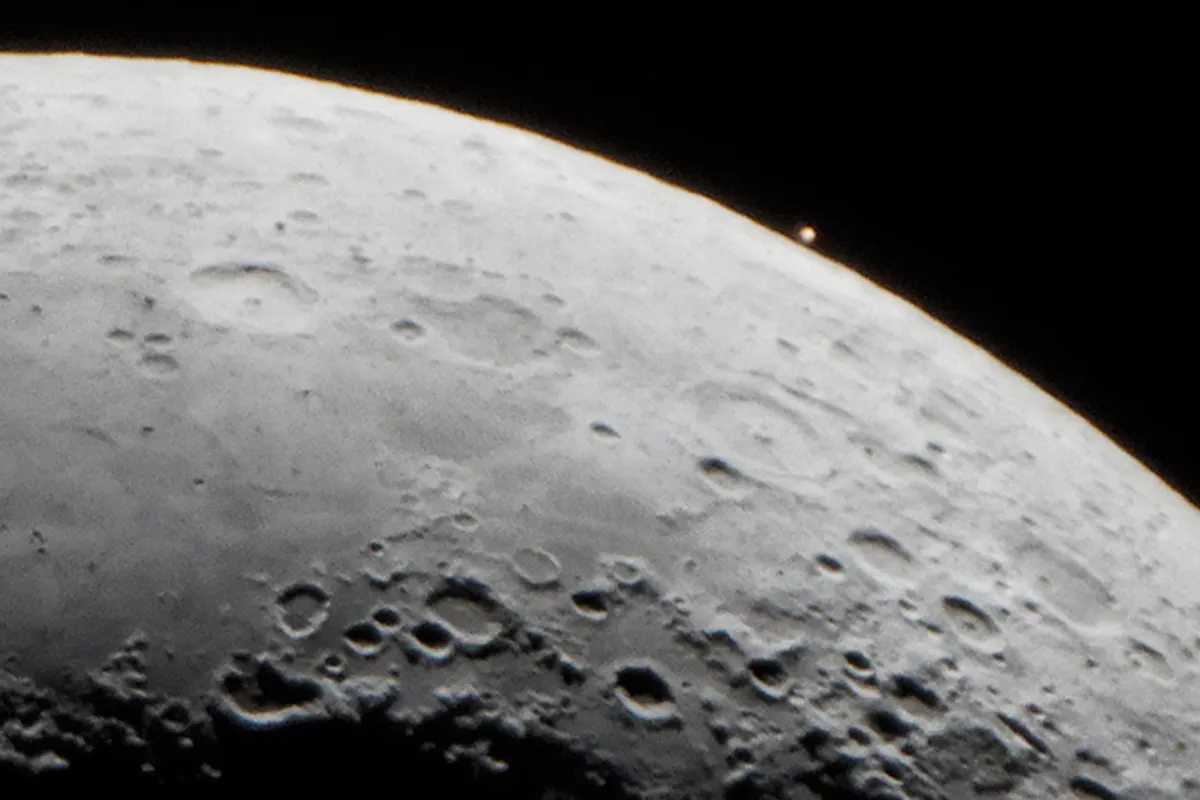There's a lunar occultation of Mars occurring this week, 18 December 2024, and in this guide we'll reveal how to photograph it.
Many were fortunate enough to see the last lunar occultation of Mars visible from the UK on 8 December 2022.
Seeing the Moon pass in front of a planet or star – a lunar occultation – is always fascinating to watch and photograph.

It places two familiar but normally separated worlds together in the same frame and highlights just how quickly the Moon appears to move.
Lunar occultations of planets can often push your skill levels too.
August 2024 saw the Moon occulting Saturn under brightening twilight conditions, when the first eye-opener was the large difference in brightness between the Moon’s surface and Saturn.
The scene required great care to deal with such a significant dynamic range.

Getting started
During the lunar occultation of Mars on 18 December 2024, the planet will be shining at mag. –0.9.
The occulting Moon will be showing an 89%-lit waning gibbous phase.
The event occurs between 09:24 and 10:15 UT (timings are for central UK; start viewing from 20 minutes earlier), when the Sun is above the horizon – this is a daylight lunar occultation of Mars.
The first hurdle will be the weather. The UK’s weather hasn’t been wonderful in 2024 and all we can do for 18 December is keep our fingers crossed.
The next hurdle is to locate the Moon. This shouldn’t be too hard, but a bright blue sky will reduce the Moon’s contrast, giving an appearance that makes it easily blend in with even the wispiest of clouds.
Look for it at a height of 13° above the west-northwest horizon.
Once you’ve found the Moon, the rest should be relatively straightforward.

Tips and techniques
At mag. –0.9, Mars will be visible in a blue sky. With a low-power instrument such as binoculars or a small telescope with a wide-angle eyepiece, it’ll appear like a small speck of light.
The Moon can be used to gauge where Mars is located relative to it, an excellent guidance assist.
Once located, using a scope attempt to get Mars in view, again using the Moon as a jumping-off point.
You should then be able to get your imaging setup pointed at the planet.
Daylight does reduce contrast, but an infrared (IR) pass filter and IR-sensitive camera will help regain some of this, darkening the blue sky.
Mars’s disappearance will be a relatively easy affair to follow, the planet disappearing behind the waning gibbous Moon’s bright leading limb.

Then comes the tricky bit. How accurate is your tracking mount?
Will it keep Mars in the centre of the imaging frame for the time the planet is behind the Moon’s disc?
If the answer is no, or if you’re not sure, you will have to make a guess as to where Mars will reappear because, under daylight conditions, the Moon’s dark edge will be invisible.
Obviously, the easy way out of this is to choose a setup that shows the whole of the Moon or at least a large portion of it, but this will lose a bit of visual impact.
Equipment
- Planetary imaging setup
- IR pass filter
- IR-sensitive high-frame-rate camera
- Equatorial tracking mount
Step-by-step
Step 1

First locate the Moon. It’ll be positioned 17˚ above the west-northwest horizon at 09:00 UT. Try to find it as early as possible to give yourself plenty of time to locate Mars.
The Sun will be up, so take care when sweeping the sky, although the Moon will be in approximately the opposite direction to the Sun.
Step 2

Once you’ve located the Moon, point your planetary imaging setup at it. Initially, we’d recommend using a low image scale, one that will allow you to capture the whole Moon or perhaps a large portion of it in one go.
Align the camera equatorially, so the Moon moves horizontally when you slew in RA.
Step 3

If you have an IR-sensitive camera and an IR pass filter, fit the filter and focus carefully on the Moon. Using our guide, attempt to find Mars.
You may have to up the gain/exposure settings to bring the sky background to a high level in order to locate the planet initially, dropping the level once you’ve found it.
Step 4

To image Mars as a disc, you’ll need increased image scale using an optical amplifier such as a Barlow lens.
This is best done when Mars is near the Moon, but not so close that you’re trying to focus as the occultation occurs! Change the image scale once you’re confident you know what Mars looks like and know where it is.
Step 5

How will you record the occultation? High-frame-rate imaging will have issues trying to stack Mars as it disappears and reappears.
One technique is to pre-image the Moon and Mars, before and after the occultation. Record the actual event itself as a video sequence, ideally keeping the frame centred on Mars.
Step 6

Once you’ve captured the disappearance and reappearance, step through your video using a video editor such as VirtualDub (freeware).
Copy a crisp frame or two and add the pre-imaged Mars disc into the shot to produce a composite of the occultation. Add labels on the image to make it clear what you’ve done.
If you photograph the lunar occultation of Mars, don't forget to send us your images and they could appear in a future issue of BBC Sky at Night Magazine.
